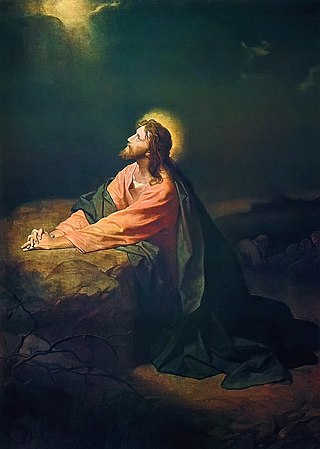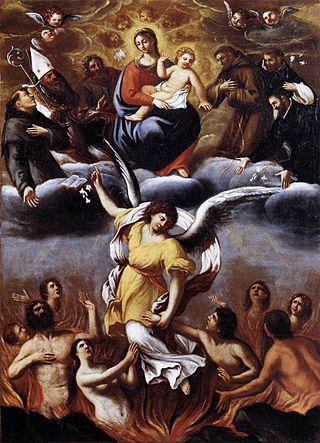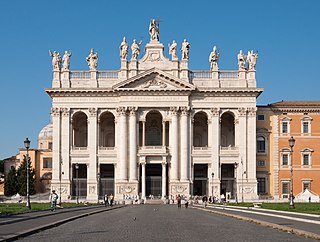
All Souls' Day, also called The Commemoration of All the Faithful Departed, is a day of prayer and remembrance for the faithful departed, observed by Christians on 2 November. Through prayer, intercessions, alms and visits to cemeteries, people commemorate the poor souls in purgatory and gain them indulgences.

Erzulie is a family of loa, or spirits, in Vodou.

In the teaching of the Catholic Church, an indulgence is "a way to reduce the amount of punishment one has to undergo for sins". The Catechism of the Catholic Church describes an indulgence as "a remission before God of the temporal punishment due to sins whose guilt has already been forgiven, which the faithful Christian who is duly disposed gains under certain prescribed conditions through the action of the Church which, as the minister of redemption, dispenses and applies with authority the treasury of the satisfactions of Christ and all of the saints".

Nicholas of Tolentino (Latin: S. Nicolaus de Tolentino,, known as the Patron of Holy Souls, was an Italian saint and mystic. He is particularly invoked as an advocate for the souls in Purgatory, especially during Lent and the month of November. In many Augustinian churches, there are weekly devotions to St. Nicholas on behalf of the suffering souls. November 2, All Souls' Day, holds special significance for the devotees of St. Nicholas of Tolentino.

In some strains of Christian theology, the Christian Church may be divided into:
Religions with the belief in a final judgment, a resurrection of the dead or an intermediate state often offer prayers on behalf of the dead to God.

The communion of saints, when referred to persons, is the spiritual union of the members of the Christian Church, living and the dead, but excluding the damned. They are all part of a single "mystical body", with Christ as the head, in which each member contributes to the good of all and shares in the welfare of all.

In Catholic tradition, the Five Holy Wounds, also known as the Five Sacred Wounds or the Five Precious Wounds, are the five piercing wounds that Jesus Christ suffered during his crucifixion. The wounds have been the focus of particular devotions, especially in the late Middle Ages, and have often been reflected in church music and art.

Our Lady of Mount Carmel, or Virgin of Carmel, is the title given to the Blessed Virgin Mary in her role as patroness of the Carmelite Order, particularly within the Catholic Church. The first Carmelites were Christian hermits living on Mount Carmel in the Holy Land during the late 12th and early to mid-13th century. They built in the midst of their hermitages a chapel which they dedicated to the Blessed Virgin, whom they conceived of in chivalric terms as the "Lady of the place." Our Lady of Mount Carmel was adopted in the 19th century as the patron saint of Chile.

The agony in the Garden of Gethsemane is an episode in the life of Jesus, which occurred after the Last Supper and before his betrayal and arrest, all part of the Passion of Jesus leading to his crucifixion and death. This episode is described in the three Synoptic Gospels in the New Testament. According to these accounts, Jesus, accompanied by Peter, John and James, enters the garden of Gethsemane on the Mount of Olives where he experiences great anguish and prays to be delivered from his impending suffering, while also accepting God's will.
Purgatorial societies are Roman Catholic Church associations or confraternities which aim to assist souls in purgatory reach heaven. The doctrine concerning purgatory, the condition of the poor souls after death, the communion of saints, and the satisfactory value of our good works form the basis of these associations.

In some forms of Christianity the intermediate state or interim state is a person's existence between death and the universal resurrection. In addition, there are beliefs in a particular judgment right after death and a general judgment or last judgment after the resurrection.

The idea of purgatory has roots that date back into antiquity. A sort of proto-purgatory called the "celestial Hades" appears in the writings of Plato and Heraclides Ponticus and in many other pagan writers. This concept is distinguished from the Hades of the underworld described in the works of Homer and Hesiod. In contrast, the celestial Hades was understood as an intermediary place where souls spent an undetermined time after death before either moving on to a higher level of existence or being reincarnated back on earth. Its exact location varied from author to author. Heraclides of Pontus thought it was in the Milky Way; the Academicians, the Stoics, Cicero, Virgil, Plutarch, the Hermetical writings situated it between the Moon and the Earth or around the Moon; while Numenius and the Latin Neoplatonists thought it was located between the sphere of the fixed stars and the Earth.
Ursula de Jesus (1604–1668) was a Roman Catholic mystic of African descent in 17-century Peru. She was born in Lima, Peru, and was the legitimate daughter of Juan Castilla and Isabel de los Rios. Isabel de los Rios was a slave, leaving Ursula to inherit her mother's status. Ursula de Jesus was an African Peruvian who rose out of slavery to become a donada in the Roman Catholic Church. She lived under her mother's owner, Gerònima de los Rios, until she was roughly eight years old. The daughter of slaves, her first experience with mysticism was when she became the property of Luisa de Melgarejo Sotomayor, a mystic and beata, lay pious woman, in Lima. In 1617 she went to the Convent of Santa Clara in Lima as the servant of Ines del Pulgar, a 16-year-old novice and the niece of the woman who owned her parents. She labored as a slave for forty-three of her sixty-two years.

A number of prayers to Jesus Christ exist within the Roman Catholic tradition. These prayers have diverse origins and forms. Some were attributed to visions of saints, others were handed down by tradition.

Purgatory is, according to the belief of some Christian denominations, an intermediate state after physical death for expiatory purification. The process of purgatory is the final purification of the elect, which is entirely different from the punishment of the damned. Tradition, by reference to certain texts of scripture, sees the process as involving a cleansing fire. Some forms of Western Christianity, particularly within Protestantism, deny its existence. Other strands of Western Christianity see purgatory as a place, perhaps filled with fire. Some concepts of Gehenna in Judaism resemble those of purgatory. In Islam, the upper most layer of hell serves as a form of purgatory for Muslim sinners.

Akan religion comprises the traditional beliefs and religious practices of the Akan people of Ghana and eastern Ivory Coast. Akan religion is referred to as Akom. Although most Akan people have identified as Christians since the early 20th century, Akan religion remains practiced by some and is often syncretized with Christianity. The Akan have many subgroups, so the religion varies greatly by region and subgroup. Similar to other traditional religions of West and Central Africa such as West African Vodun, Yoruba religion, or Odinani, Akan cosmology consists of a senior god who generally does not interact with humans and many gods who assist humans.

There are extensive and varied beliefs in ghosts in Mexican culture. In Mexico, the beliefs of the Maya, Nahua, Purépecha; and other indigenous groups in a supernatural world has survived and evolved, combined with the Catholic beliefs of the Spanish. The Day of the Dead incorporates pre-Columbian beliefs with Christian elements. Mexican literature and cinema include many stories of ghosts interacting with the living.

The Latin Church is the largest autonomous particular church within the Catholic Church, whose members constitute the vast majority of the 1.3 billion Christians in communion with the pope in Rome. The Latin Church is one of 24 churches sui iuris in communion with the pope; the other 23 are collectively referred to as the Eastern Catholic Churches, and have approximately 18 million members combined.

Haitian Vodou art is art related to the Haitian Vodou religion. This religion has its roots in West African traditional religions brought to Haiti by slaves, but has assimilated elements from Europe and the Americas and continues to evolve. The most distinctive Vodou art form is the drapo Vodou, an embroidered flag often decorated with sequins or beads, but the term covers a wide range of visual art forms including paintings, embroidered clothing, clay or wooden figures, musical instruments and assemblages. Since the 1950s there has been growing demand for Vodou art by tourists and collectors.
















